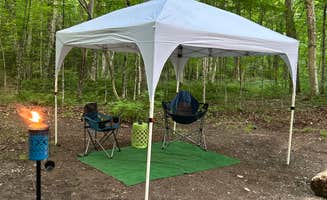Primitive camping near Grand Isle, Vermont centers on undeveloped sites in the Green Mountain National Forest. During spring thaws, many forest roads become muddy with standing water that persists through early summer. Fall temperatures drop rapidly after sunset, often reaching 30-40°F even when daytime temperatures exceed 70°F. Sites typically sit at elevations between 900-2,500 feet, requiring campers to prepare for temperature variations and changing conditions.
What to do
Hiking from campsites: Access multiple trail connections from Lincoln Dispersed Camping. According to one camper, "We walked past the gate beyond the end of the road followed a trail up 500 feet or so of elevation in the foothills to the west of Mt Ellen. Found one more camp site." The trail continues into higher elevations with mushroom gathering opportunities.
Water activities: Austin Brook provides direct access to streams and the Mad River. One visitor notes, "All pretty much have access to the streams," making these sites ideal for fishing, wading, or cooling off during summer months.
Photography: Seasonal colors and moving water create photographic opportunities near forest campsites. A visitor to Austin Brook mentioned, "I didn't get the chance to camp here, it was full when I drove through looking for a place. So I came back later in the weekend for pictures. Great location, easy access, on a nice brook."
What campers like
Natural soundscapes: Forest camping areas provide notable quiet compared to developed campgrounds. At Lincoln Dispersed Camping, campers report "Very quiet, though we could hear the occasional dog barking from houses in the Downingville area," offering a more secluded experience than front-country options.
Water proximity: Many dispersed sites feature water access for filtering, cooling off, or ambiance. One camper at Lincoln describes "beautiful secluded campsites - Yards away from gorgeous running water," making water access a primary benefit of these locations.
Fire rings: Many primitive sites include established fire rings despite minimal other infrastructure. At Austin Brook, visitors note "4 fire rings" are available among the limited number of sites, allowing for traditional camping experiences when seasonal restrictions permit.
What you should know
Vehicle requirements: Forest roads leading to dispersed camping areas present challenges for low-clearance vehicles. For Chapel Pond Camping, approach roads feature seasonal ruts and erosion that worsen after heavy rains, potentially requiring 4WD during wet periods.
Supplies and provisioning: Pack in all necessities as services are limited. Near Lincoln Dispersed Camping, "Lincoln General Store is 3.5 miles away via Downingville. Some modest resupply options there," but selection remains limited compared to larger towns.
Wildlife considerations: Bears inhabit the Green Mountain National Forest, requiring proper food storage. One Lincoln camper noted they "Saw no bear sign, but kept all food in car as a precaution," following standard protocol for backcountry camping in the region.
Tips for camping with families
Site selection priorities: Choose sites with adequate space and minimal hazards. Austin Brook offers varied options where "When driving in on the right there's a culdesac type set up of sites," providing more contained spaces that work well for family groups needing to maintain sight lines to children.
Water safety planning: Jones Pond and similar water-adjacent sites require careful supervision of children near water. Sites positioned closest to streams carry higher risks during sudden rainstorms when water levels can rise rapidly.
Location verification: Confirm site locations before arrival as mapping applications sometimes provide incorrect coordinates. One visitor noted, "This is a beautiful little pull off the road right on the river with tables & fire rings. For correct coordinates look at Fire Road 25."
Tips from RVers
Turnaround space: Forest roads often end with limited turning radius for larger vehicles. At Austin Brook, "Road is short dead ends with a decent amount of turn around space," but conditions vary seasonally and space narrows when multiple vehicles are present.
Road conditions assessment: Before attempting forest roads with an RV, assess conditions or seek recent visitor reports. Regarding Lincoln, one camper specified "FR 291 is a somewhat primitive road - lots of big puddles. I would want some clearance for a vehicle. Our Toyota Highlander made it easily," indicating potential challenges for larger or longer vehicles.



